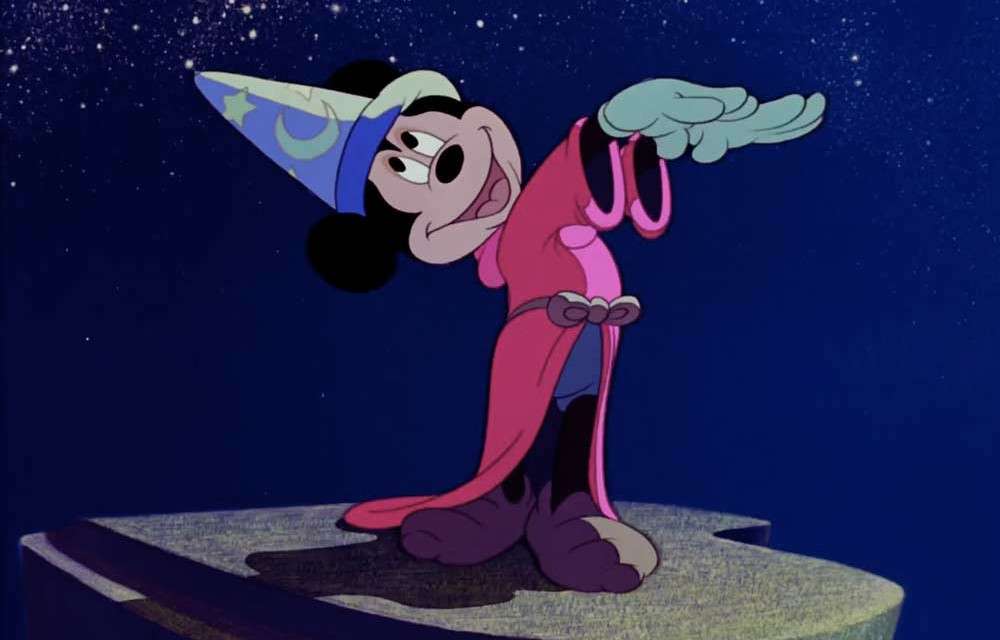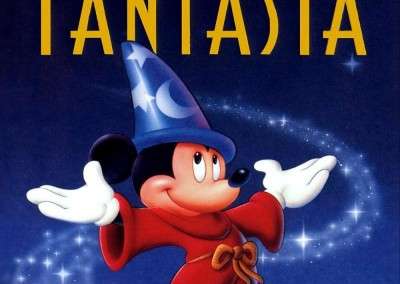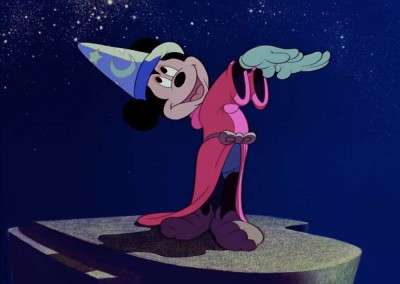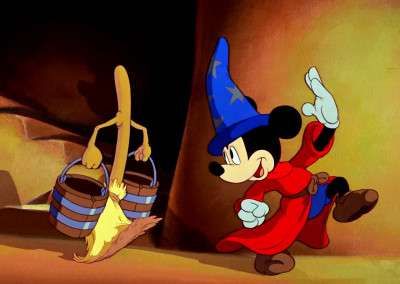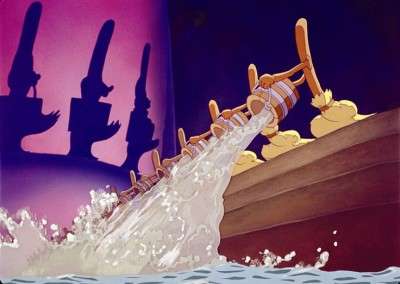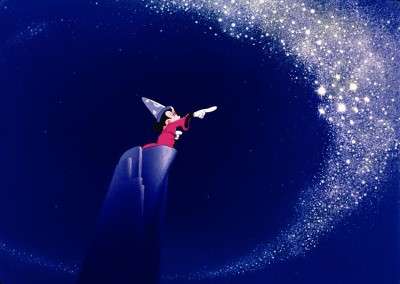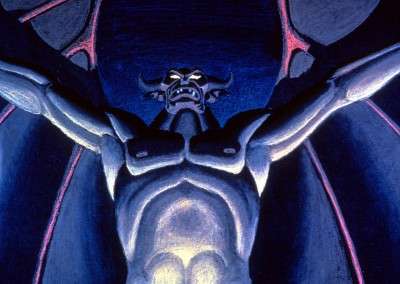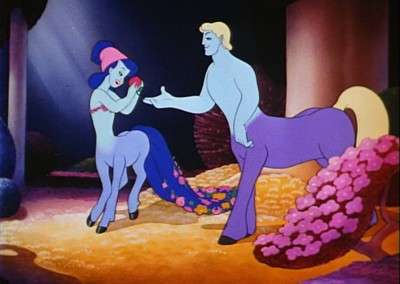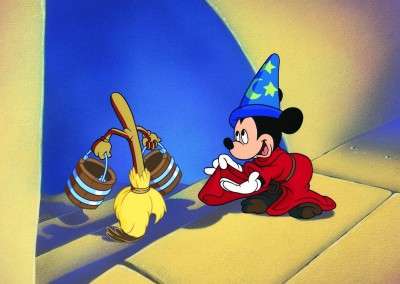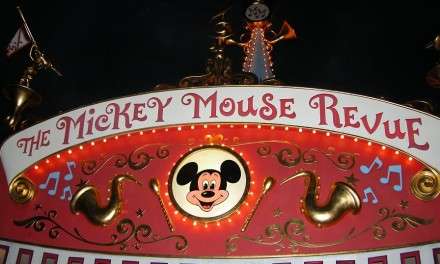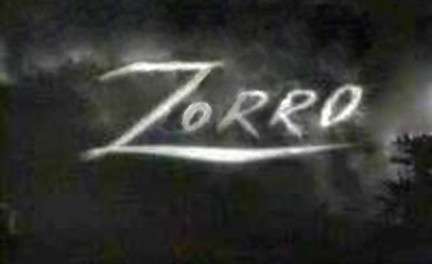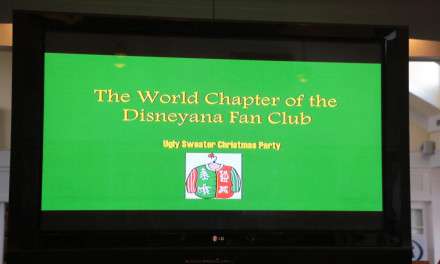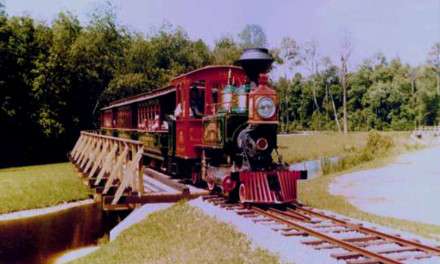I will never forget the first time I saw Fantasia. I hate to say, but I despised it! Of course, I was only about 8 years old at the time. For a kid weaned on the Silly Symphonies and the Mickey cartoon shorts, this was not what I expected. Not many eight year old’s understand nor like classical music. But today, I marvel at its artistic creativity and now understand the concept of what Walt Disney was trying to convey with this ahead of its time animation feature.
The evolution of Fantasia goes way back to the early days at Walt’s studio. Music had always played an important and integral part in the studios cartoons. In the beginning, the music accompanying the cartoon always followed the action of the cartoon. In early 1929, Walt wanted to do a series of cartoon shorts called the “Silly Symphonies” where his artists could express themselves without a central character, and expand their talents. It was then that he and Carl Stalling, his organist friend from Kansas City decided that the cartoons would move in response to the music. Fantasia eventually morphed into a full-length animated feature showcasing eight animated segments each accompanied by their individual classical musical compositions, it started out as a comeback vehicle for Mickey Mouse. But by no means was Walt a classical music expert.
As early as 1937, Walt demeaned the decline in the popularity of his Mickey Mouse. Although still extremely popular, he was being eclipsed by Donald and Goofy. The reason? Mickey started out being brash, bold and brazen, but over the few years, he became more of a company symbol, domesticated. Everyone said…”Mickey would not say that, or do that” so it became harder and harder to write for him. Walt wanted a vehicle for Mickey to bring him back into the fold. He decided to star Mickey in a cartoon short based on the poem written by the great German Poet and novelist Johann Wolfgang von Goethe, set to a piece by French composer Paul Dukas’ scherzo “L’Apprenti Sorcier” or the sorcerer’s apprentice, about a wizard’s study who used the wizard’s hat and scepter with amusing results. He called piece the “Concert Feature”, where “Sheer Fantasy unfolds to a musical pattern” without being restricted by the illusion of reality, in other words “Abstract films”. The idea of the “Concert Feature” was to demystify the music by visualization. Walt Said…”We wouldn’t worry a damn bit about the stiff shirts that are supposed to be the ones that this music is created for, he said to his story men at a meeting…”There’s a great mass of people who would appreciate this music if they didn’t have to sit through stuff like an opera”
In 1937 at Chasens restaurant in Los Angeles, he spotted Polish born symphony conductor Leopold Stokowski, conductor of the Philadelphia Orchestra since 1912, and discussed with him his idea the musical short. The meeting was destiny because Disney considered using a well-known conductor to record the music for added prestige. Stokowski was happy to collaborate on the project, and offered to conduct the piece at no cost. This was the start of their collaboration on The Concert Feature. Animation on The Sorcerer’s Apprentice began on January 21, 1938, when the director James Algar, assigned animator Preston Blair to work on the scene when Mickey Mouse wakes from his dream. In this animated sequence, Mickey Mouse would star as his did in the past, as the “everyday man.” There was to be no dialogue, just music, and, of course, the animation.
Disney and Stokowski signed an agreement on December 16, 1937, allowed the conductor to “select and employ a complete symphony orchestra” for the recording of the Sorcerer’s Apprentice. after many recording sessions with Stokowski conducting Duka’s score, he realized that the Sorcerer’s Apprentice was too long and expensive for one cartoon short and decided that it would be just one segment of a feature that sets animation to classical music, and drafted a new contract with Stokowski to conduct the whole score for the new “Concert feature” as he was going to call it. Walt had always wanted to do more poetic, musically inclined shorts. Walt and Stokowski wanted to popularize classical music. Walt wanted an intermediary between classical composers and the American audience. When during a meeting, his brother Roy asked why couldn’t the music be something that “Just the ordinary guy like me can like” Walt gave an icy glare and ordered him out of the room. “The importance of the piece was schooling the audience and expanding the vehicle. Even if it’s a flop, he told his staff, “We’ll have gained a thorough appreciation of what can be done with music”. Ideas to produce a complete feature film were pursued in February, 1938. It was then that Walt realized that the viewer should truly “hear” the music. Thus, began the creation of “Fantasound. “This was a revolutionary new sound system especially made just for Fantasia. This new system would guarantee proper sound synchronization, and quality.
On January 18, 1939, Stokowski signed an eighteen-month contract with Disney to conduct the remaining pieces with the Philadelphia Orchestra. Recording began that April and lasted for seven weeks at the Academy of Music, the orchestra’s home which was chosen for its excellent acoustics. Walt and Stokowski decided that presenting the film with an on-screen host would be a boost. They chose composer and music critic Deems, and agreed he would be the best choice for the role. Narrator Deems welcomes the audience to a “new form of entertainment,” and in his introduction sets the scene. It took much time and discussion to make the final choice for the eight classical compositions for the entire film. The feature continued to be known at the Concert Feature or Musical Feature, late as November, 1938. However, Hal Horne the publicist for distributor RKO Radio Pictures wanted a different title. Stuart Buchanan, Disney’s casting director held a contest at the studio for a new title. Producing more than 1,800 suggestions, including “Fantasia” which was embraced by Horne, and became the title of the feature. The name “Fantasia” does have two meanings…Compositions in which the composer strays from the accepted form, and a potpourri of familiar arts.
The final eight pieces in Fantasia are… Toccata and Fugue in D Minor by Johann Sebastian Bach, The Nutcracker Suite by Piotr Ilich Tchaikovsky, The Sorcerer’s Apprentice by Paul Dukas, The Rite of Spring by Igor Stravinsky, The Pastoral Symphony by Ludwig van Beethoven, Dance of the Hours by Amilcare Ponchielli, Night on Bald Mountain by Modeste Moussorgsky and Ave Maria by Franz Shubert. What made the feature unique was the new sound system of “Fantasound”. Walt was always experimenting. He wanted the best sound for this feature. He said… “Music emerging from one speaker behind the screen sounds thin, tickly and strainy. We wanted to reproduce such beautiful masterpieces … so that audiences would feel as though they were standing at the podium with Stokowski”.
Disney contacted Dave Sarnoff of RCA about such a system that would… “Create the illusion that the actual symphony orchestra is playing in the theater.” Not sure at first how to make such a system, Disney and RCA engineers finally came up with a pioneering stereophonic surround sound system which revolutionized some processes widely used today, including simultaneous multi-track recording, overdubbing, and noise reduction. The big problem was cost and fitting the new system into existing theaters. When finally completed, over a thousand technicians and artists were employed in the making of Fantasia, which had more than 500 animated characters. It was truly a masterpiece.
Fantasia was first released on November 13th, 1940 in theatrical roadshow engagements. The first engagement was at the Broadway Theater, the Old Colony Theater where Steamboat Willie first premiered 13 years earlier. The remaining twelve roadshows were held during 1941, which included a thirty-nine week run at the Carthay Circle Theatre in Los Angeles from January 29. Disney took out a year lease with the theater, which took technicians a week to install the Fantasound equipment. Demands for tickets were so great that eight telephone operators had to handle the extra calls. It ran for 49 consecutive weeks, longest by a film at the time. It ran for 57 weeks until February 28th, 1942. It ran for 39 weeks at the Carthay Circle Theatre in Los Angeles, breaking a record of 28 weeks held by Gone with the Wind. But as popular as it was, it received mixed critical reviews, and could not make a profit because the War in Europe cut off the many lucrative markets there. In addition, the high production costs, expense of renting theaters and the cost to install the Fantasound system, cut into profits.
Some of the reviews were as such… Among those at the film’s premiere was film critic Edwin Schallert of the Los Angeles Times who considered the film to be a magnificent achievement in film which would go down in film history as a landmark film, noting the rapturous applause the film received by the audience during the various interludes. He stated that Fantasia was “caviar to the general, ambrosia and nectar for the intelligentsia” and considered the film to be “courageous beyond belief” Bosley Crowther of The New York Times, noted that “motion-picture history was made last night … Fantasia dumps conventional formulas overboard and reveals the scope of films for imaginative excursion”. “Fantasia … is simply terrific!” Variety also acclaimed Fantasia, calling it “A successful experiment to lift the relationship from the plane of popular, mass entertainment to the higher strata of appeal to lovers of classical music!” Dance Magazine committed its lead story to the film, saying that “The most extraordinary thing about Fantasia is, to a dancer or balletomane, not the miraculous musical recording, the range of color, or the fountainous integrity of the Disney collaborators, but quite simply the perfection of its dancing!”
The negative reviews came mostly from the classical musical community. Many disliked Stokowski’s handling of the music. Igor Stravinsky, whose music was showcased in the film, did not like Stokowski’s arrangement of the “Rite of Spring” and did not enjoy the orchestra’s performance, stating too much simplification of the score. Other critic’s leveled displeasure at the premise of the film itself, arguing that presenting classical music with visual images would rob the musical pieces of their integrity. Critic Olin Downes of The New York Times hailed the quality of sound that Fantasound presented, but said, “Much of Fantasia distracted from or directly injured the scores.” Even some parents complained about paying the higher roadshow prices for their children, and several stated that the Night on Bald Mountain segment had frightened them. From a breakdown of the reviews found 33% very positive, 22% positive, and 22% both positive and negative and 16% negative, the general response was still overwhelmingly favorable. Despite during multiple re-releases with the original footage and audio being modified, deleted or restored, Fantasia has grossed approximately $76.4 million dollars and is the 22nd highest grossing film in the US adjusting for inflation. In 1998 the American Film Institute ranked it as the 58th greatest American film in their 100 Years…100 Movies and the fifth greatest animated film in their 10 Top 10 list.
Walt Disney made this comment about Fantasia… “Fantasia is timeless. It may run ten, twenty, thirty years. “Fantasia’ is an idea in itself. I can never build another. I can improve. I can elaborate. That is all.” And that is enough. Walt, as always was proved to be right again. It is beloved today in this high-tech, computer driven world. It has stood the test of time and it was ahead of its time. And as Walt had quipped…”Fantasia is timeless”!

